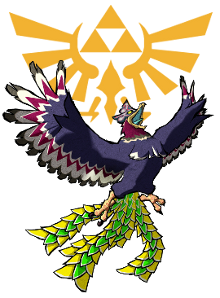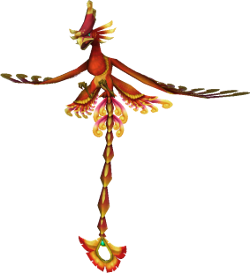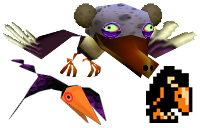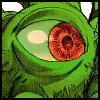Zelda and Mythology: Mythical Birds
Posted on July 13 2012 by Axle D. Wilder
 In the first installment of Zelda and Mythology, I discussed Arthurian Legend and its similarities to Zelda. I have decided to do the promised sequel — about Celtic Mythology in general — at a later date, and instead we will be talking about mythical birds and the many references and similarities to them that can be found in The Legend of Zelda.
In the first installment of Zelda and Mythology, I discussed Arthurian Legend and its similarities to Zelda. I have decided to do the promised sequel — about Celtic Mythology in general — at a later date, and instead we will be talking about mythical birds and the many references and similarities to them that can be found in The Legend of Zelda.
Of all tetrapod vertebrates (animals with backbones and four limbs), birds are the most rich in species, so it should come as no surprise that they have cultural significance or that there’s an abundance of mythological birds as well as myths about real bird species. With birds being so prominent, then, it should also come as no surprise that many fantasy stories implement their own fictional avians, including inspirations from myth and even actual creatures ripped straight out of it. Zelda, too, has an abundance. So here are three major mythical birds and their appearances in Zelda, along with three real birds with associated myths that have also appeared.
Roc
Originating from Arabic and Persian mythology, the Roc, or Rukh, is sometimes considered to be the same as the Simurgh (also Persian) and also compared to Ziz from Jewish mythology. It should be a familiar name to Zelda fans; we’ve heard that name many times, either alone or as part of a longer name.
There are the items, Roc’s Feather and Roc’s Cape, and then many, many bird or birdlike enemies ending with a similar suffix: Helmaroc King, Kargaroks, Argorok, and Hroks. All of these creatures are clearly based on the Roc.
The Roc is an enormous bird of prey, usually white. Multiple stories about the Roc depict it as a creature that carries off large animals to feed on later, usually dropping them so they break apart for easy feeding. It’s also been described attacking ships at sea. The Simurgh on the other hand, while also a gigantic bird of prey, is identified often as a benevolent creature.

Ignoring the differences with the Simurgh and focusing on the Roc, there are a lot of notable similarities to the creatures appearing in Zelda aside from the name. To start, while Roc’s trait of being white doesn’t fit all of Zelda’s examples of it, it should noted that the tips of both the Helmaroc King’s and Kargaroks’ feathers in The Wind Waker are white, and more important, Roc’s Cape is white and Roc’s Feather usually is, or is close. The roc/rok enemies also first showed up in The Wind Waker, with the Helmaroc King attacking Tetra’s ship, bringing to mind the stories of the Roc attacking sailors. The Hroks in Skyward Sword, on the other hand, are large birds that drop rocks on top of Link, mildly similar to how the Roc drops its prey to kill them.
Argorok is a notable exception from all of this, given that it’s more reptilian than avian — clearly based on a dragon — and is red and black, not white. I believe Argorok is clearly a more original evolution of the enemy concept that began in The Wind Waker.
It should also be noted that the term “Thunderbird” in cryptozoology — the study of animals not proven to exist — applies to creatures similar to the Roc. The name however originates from Native American mythology, and the Thunderbird from there will be discussed separately later in the article.
Phoenix
 The Phoenix is an extremely well-known mythical creature, similar to the Slavic Firebird, making references to it extremely obvious in fiction in general. However, it’s only referenced once in the Zelda series, which is surprising when you compare it to the far less commonly referenced Roc which is mentioned constantly in Zelda. The only Phoenix reference currently found in Zelda is in the Furnix from Skyward Sword.
The Phoenix is an extremely well-known mythical creature, similar to the Slavic Firebird, making references to it extremely obvious in fiction in general. However, it’s only referenced once in the Zelda series, which is surprising when you compare it to the far less commonly referenced Roc which is mentioned constantly in Zelda. The only Phoenix reference currently found in Zelda is in the Furnix from Skyward Sword.
The Phoenix can be found in many Eurasian mythologies, including Arabian, Persian, Greek, Roman, Egyptian, Chinese, and Indian. It’s described and depicted as a bird with colorful plumage, most commonly a tail of gold and scarlet, and was said to look like a stork or heron by the Egyptians, and a peacock or eagle by the Greeks. The Phoenix lives a 500 to 1000 year life, after which it builds a nest and burns itself along with it, and out of the ashes it is reborn anew (or in some versions, the “reborn” Phoenix is simply its offspring).
The name of the Furnix is a clear reference to the Phoenix, being a combination of that name and “furnace”, and their similarity in appearance to the Phoenix (and even the Firebird) is uncanny, especially in the exact depiction of red and gold plumage and their overall physical appearance, which combines traits of the creatures the Phoenix is said to look like. The fire association, while somewhat cliche for monsters in general, is notable because this is the only fire-based bird in Zelda’s 25 years of monsters. The Furnix is clearly heavily based on the Phoenix, and in fact is virtually an exact, accurate depiction with almost no change.
Thunderbird
The original Thunderbird, as I said, is a Native American creature. If you’ve ever seen a Native American totem pole with a bird at the top, well, that’s Thunderbird. It’s typically a supernatural entity, often said to either control and bring storms and lighting, or simply to make noise like thunder when it beats its wings. Sometimes the Thunderbird is a single entity and sometimes a species, but it’s always intelligent, powerful, and wrathful; it is considered a grave mistake to anger a Thunderbird. As a single entity, the Thunderbird serves the Great Spirit, but as a species they can take human form by tilting back their beak like a mask and removing their feathers like a cloak.
 In Adventure of Link, the second-to-final boss is also called Thunderbird. Its artwork shows it as a freaky winged monster with humanoid features, bringing to mind the species of Thunderbirds who could turn into humans. Further supporting this is the fact that the in-game sprite reveals its human-like face — its weak point — when hit by the Thunder spell. Like the Thunderbird species, this boss possesses human traits that it does not always show.
In Adventure of Link, the second-to-final boss is also called Thunderbird. Its artwork shows it as a freaky winged monster with humanoid features, bringing to mind the species of Thunderbirds who could turn into humans. Further supporting this is the fact that the in-game sprite reveals its human-like face — its weak point — when hit by the Thunder spell. Like the Thunderbird species, this boss possesses human traits that it does not always show.
The Thunderbird’s sprite also appears to possess a Native American-style headdress, an odder similarity to its Native American inspiration. The fact that the Thunderbird as a singular entity serves the Great Spirit, and the Thunderbird of Adventure of Link is a guardian placed in the Great Palace by the King, is another aspect where the game mirrors the myth.
It should be noted that the Rito from The Wind Waker are a bird species with a culture resembling that of Native Americans, so they also resemble the Thunderbird as a species. This may or may not be intentional.
Eagles
Moving on from completely mythical birds, many real species of bird have myths or religious practices associated with them. The eagle, for example, was worshiped by the Moche people of ancient Peru and was the patron animal of the Greek god Zeus. Native Americans would give Eagle feathers to those from other tribes or even foreigners if they were considered worthy.
 Eagles are only featured in two Zelda games, which are Adventure of Link where there are three derivative creatures, and in Link’s Awakening, where the giant Evil Eagle is a boss. The Moby from Adventure of Link is a simple bird that looks like an eagle. Then there are the Fokka and Fokkeru from the same game, both resembling humanoid eagle monsters. Interestingly, both of these eagle-men are only encountered in the Great Palace, the same location as Thunderbird. The original Thunderbird is assumed to have been based on the Bald Eagle, but otherwise has no eagle affiliations aside from being considered important like the eagle feather was.
Eagles are only featured in two Zelda games, which are Adventure of Link where there are three derivative creatures, and in Link’s Awakening, where the giant Evil Eagle is a boss. The Moby from Adventure of Link is a simple bird that looks like an eagle. Then there are the Fokka and Fokkeru from the same game, both resembling humanoid eagle monsters. Interestingly, both of these eagle-men are only encountered in the Great Palace, the same location as Thunderbird. The original Thunderbird is assumed to have been based on the Bald Eagle, but otherwise has no eagle affiliations aside from being considered important like the eagle feather was.
If one really wanted to, they could connect the Fokka and Fokkeru to Garuda from Hindu and Buddhist mythology. Garuda is depicted as an eagle man, but doesn’t share any further similarities to the simple enemies from Adventure of Link, so the connection is forced. The only other thing worth noting is that Fokka and Fokkeru, like Thunderbird, show up exclusively in the Great Palace, making them more agents of the King, which befits the reverence many cultures had for the eagle. However, this connection does not work for the Moby or Evil Eagle; the latter is essentially just a large, powerful and wild eagle, making it fit the Roc and Thunderbird more than traditional eagles.
Crows
 Crows also sometimes appear in the Zelda series in both 2D and 3D games. Guays, Takkuris, and Crows (literally named directly off the animal) are the crow enemies that appear in the series (though the Takkuri’s design in Majora’s Mask also resembles a vulture). These enemies have no importance and few notable features.
Crows also sometimes appear in the Zelda series in both 2D and 3D games. Guays, Takkuris, and Crows (literally named directly off the animal) are the crow enemies that appear in the series (though the Takkuri’s design in Majora’s Mask also resembles a vulture). These enemies have no importance and few notable features.
Real crows are fairly commonly seen as symbols of death, particularly in Irish mythology where they are associated with Morrigan, the goddess of war and death (not to be confused with Morgan le Fay from Arthurian Legend), and Bran the Blessed, another god associated with death. They’re also often tricksters or thieves, which is the most comparable to the crows in Zelda (where they are usually rupee or item thieves), but the thief depiction is actually derivative of real-life crows and not myth; crows are sometimes believed to favor shiny objects.
They also appear in more benevolent roles, most notably in Norse mythology as Odin’s information-gatherers, and in Native American mythology as a world creator, but neither of these correlate to their appearances in Zelda.
Owls
 And last but not least, we have owls. Kaepora Gaebora is an infamous owl character in the series, and there’s also his prototype, the nameless owl from Link’s Awakening. Both are mysterious, pseudo spiritual characters who offer guidance. There are also Owl Statues associated with both that do the same.
And last but not least, we have owls. Kaepora Gaebora is an infamous owl character in the series, and there’s also his prototype, the nameless owl from Link’s Awakening. Both are mysterious, pseudo spiritual characters who offer guidance. There are also Owl Statues associated with both that do the same.
In a staggering amount of myths, owls are identified as bad omens and harbingers of death. Only in the modern West are they seen in a more positive light, where they’re often associated with wisdom. This usually comes from Athena, patron goddess of Athens in Greek mythology, whose symbol was an owl. Athena was the goddess of wisdom, civilization, law, the arts, and just warfare, among many other things.
The wisdom association fits Zelda’s owl guides, but there is little else to say about them unless a future Zelda game depicts an evil death owl… which would be awesome.
In closing…
One final interesting note is the Hylian Crest — along with its cousin the Royal Crest and predecessor the Goddess Crest — depicts a bird, clearly derived from the Loftwings which look almost identical to the real-life shoebill. This is reminiscent of real crests and symbols, both modern and ancient, which depict mythological birds like the Phoenix, as well as the other real birds I’ve mentioned, like the eagle and crow. This doesn’t really say much beyond the fact that it helps to prove how prominent birds are in nature and culture, both real and within the Zelda series. They have a major place in both human culture and fiction, and come in a huge variety of forms, ranging from the very traditional to the highly unusual.
It’s cool to see them featured so much in Zelda, and hopefully we’ll see some more interesting bird creatures in future games as well as more references to bird myths. It would be excellent to see derivatives of some of the ideas discussed here, like the wise and benevolent crow or the evil owl (the latter of which would probably be a great inside joke for haters of Kaepora Gaebora), and there are many other situations that could be crafted with the creatures Nintendo has already touched on. Birds are one of my favorite animals, so I’m definitely hoping we see more cool bird references in Zelda. But how about you? How do you feel about these creatures, these myths, and my connections? Did you learn anything? Tell me in the comments!





